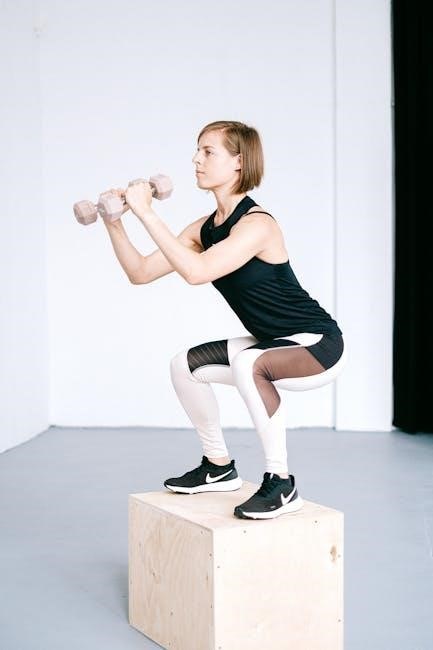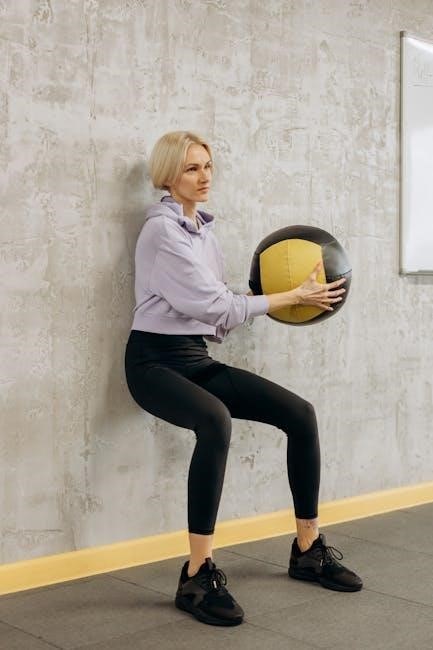Calisthenics training is a time-tested method using bodyweight exercises to enhance strength, flexibility, and coordination. It offers a holistic approach to fitness, empowering individuals to achieve their goals without equipment, fostering mental and physical resilience while promoting self-improvement and overall well-being.
What is Calisthenics?
Calisthenics is a form of exercise that uses bodyweight to improve strength, agility, balance, flexibility, and coordination. It involves no equipment, making it accessible anywhere. These exercises, such as push-ups and squats, work multiple muscle groups, enhancing physical fitness effectively. Calisthenics is versatile, catering to all fitness levels, from beginners to advanced athletes, and supports various goals like muscle building or cardiovascular health. Its simplicity and effectiveness make it a popular choice for those seeking a holistic workout without gym memberships or special gear.
Benefits of Calisthenics Training
Calisthenics training offers numerous benefits, including improved strength, agility, balance, flexibility, and coordination. It enhances overall physical fitness without requiring equipment, making it highly accessible. Regular practice boosts mental resilience and discipline, fostering a strong mind-body connection. Calisthenics is versatile, suitable for all fitness levels, and can be adapted to achieve various goals, such as muscle building or cardiovascular health. Its holistic approach promotes full-body workouts, ensuring comprehensive development and overall well-being, making it an excellent choice for sustainable fitness.

Advantages of a Calisthenics Training Program
A calisthenics training program offers a versatile, cost-effective, and efficient way to improve strength, flexibility, and cardiovascular health without equipment, making it ideal for all fitness levels and lifestyles.
Equipment-Free Workout
A significant advantage of calisthenics is its equipment-free nature, allowing workouts anywhere, anytime. This accessibility makes it ideal for those with limited resources or preferring home training. Bodyweight exercises like push-ups, squats, and planks form the core of routines, ensuring effective fitness without financial investment in gym memberships or equipment. The simplicity of calisthenics democratizes fitness, enabling everyone to achieve strength, flexibility, and coordination regardless of their location or budget, promoting a sustainable and adaptable approach to health and wellness.
Improved Strength and Flexibility
Calisthenics training enhances strength and flexibility by engaging the body’s natural movement patterns. Bodyweight exercises like push-ups, squats, and lunges target major muscle groups, building lean muscle and improving mobility. Progressive overload, achieved through variations and increased reps, ensures continuous strength gains. Flexibility is boosted as exercises promote full-range motion, reducing stiffness and enhancing coordination. This holistic approach to fitness fosters overall physical development, making calisthenics a versatile and effective method for achieving strength and flexibility goals without equipment.
Convenience and Accessibility
Calisthenics training offers unparalleled convenience, requiring no specialized equipment or gym memberships. Exercises can be performed anywhere, from home to outdoor spaces, making it ideal for those with busy schedules or limited access to facilities. Its accessibility ensures that anyone, regardless of location or resources, can adopt a consistent workout routine. This flexibility makes calisthenics a practical choice for maintaining fitness, fostering a culture of self-reliance and adaptability that suits diverse lifestyles and goals effectively.

Key Components of a Calisthenics Training Program
A well-structured calisthenics program includes bodyweight exercises, progressive overload, and a balanced approach to strength, flexibility, and cardiovascular fitness, ensuring sustainable and effective results over time.
Setting Clear Fitness Goals
Setting clear fitness goals is crucial for a successful calisthenics program. Define specific, measurable objectives, whether improving strength, endurance, or flexibility. Identify your motivation and track progress. Short-term goals, like mastering a push-up, build momentum, while long-term goals, such as advanced exercises, keep you focused. A structured plan with achievable milestones ensures consistency and motivation, helping you stay committed to your training and celebrate successes along the way. Regularly reassess and adjust your goals to maintain progress. This approach fosters discipline and accountability, key to reaching your full potential in calisthenics. A well-defined path enhances your journey, ensuring steady improvement and satisfaction.
Understanding Basic Exercises
Mastering basic calisthenic exercises is essential for building a strong foundation. Push-ups, squats, lunges, and planks are fundamental movements that target multiple muscle groups, enhancing overall strength and stability. Proper form and technique are crucial to maximize effectiveness and prevent injury. Start with modified versions if needed, gradually increasing difficulty as you progress. Consistency in performing these exercises lays the groundwork for more advanced routines, ensuring a balanced and effective workout. Understanding and excelling in these basics will empower you to tackle complex movements with confidence and precision, driving continuous improvement in your fitness journey.
Creating a Structured Routine
A well-structured calisthenics routine ensures steady progress and avoids plateaus. Start by identifying your fitness goals and organizing exercises into focused sessions, such as upper body, lower body, and core workouts. Incorporate a mix of foundational movements like push-ups, squats, and lunges, while gradually introducing variations to challenge yourself. Aim for consistency, with 3-4 workouts per week, and include warm-ups, cool-downs, and recovery strategies. Tracking your progress and adjusting the routine as needed will keep your training effective and engaging, helping you stay motivated and achieve long-term success.

How to Structure a Calisthenics Workout Plan
Begin with a warm-up, followed by exercises split by muscle groups. Include compound movements like push-ups and squats, then finish with cool-down stretches and recovery techniques.
Warm-Up and Cool-Down Routines
A proper warm-up prepares the body for exercise by increasing blood flow and flexibility, reducing injury risk. Start with dynamic stretches like arm circles, leg swings, and torso twists. Light cardio such as jogging in place or jumping jacks can also be included. After the workout, a cool-down with static stretches for hamstrings, quadriceps, and chest muscles helps improve recovery. Finish with deep breathing exercises to relax the mind and body, ensuring a smooth transition back to a resting state while preventing muscle soreness and promoting recovery.
Splitting Workouts by Muscle Groups
Organizing workouts by muscle groups ensures balanced development and prevents overtraining. Focus on upper body one day, targeting push-ups, pull-ups, and core exercises. Dedicate another day to lower body, including squats, lunges, and calf raises. This structured approach allows for adequate recovery and progressive overload. For full-body sessions, combine compound movements like burpees and mountain climbers. Tailor splits to fitness goals, whether strength, hypertrophy, or endurance, ensuring each muscle group receives attention for holistic growth and sustained progress. Consistency and variety are key to success in any calisthenics program.
Progressive Overload for Muscle Growth
Progressive overload is essential for muscle growth in calisthenics. Gradually increase intensity by adding reps, sets, or difficulty to exercises. For example, advance from push-ups to single-arm or decline variations. Incorporate timed holds or slower tempos to challenge muscles further. Consistency and patience are key, as muscle growth requires time. Track progress and adjust routines to avoid plateaus. This method ensures continuous improvement and strengthens both the body and mind, fostering long-term fitness success and a lean, powerful physique.
Popular Calisthenics Exercises for Beginners
Popular calisthenics exercises for beginners include push-ups, bodyweight squats, lunges, and planks. These foundational movements build strength and coordination, with modifications available to suit all fitness levels.
Push-Ups and Variations
Push-ups are a cornerstone of calisthenics, targeting the chest, shoulders, and triceps. They improve upper body strength and can be modified to suit fitness levels. Beginners can start with knee push-ups, while intermediates can progress to decline or single-arm variations. Proper form ensures effectiveness and prevents injury. Incorporating push-up variations into routines helps build muscular endurance and promotes progressive overload, essential for continuous strength gains. Consistency and gradual progression are key to mastering this versatile exercise and achieving overall fitness goals.
Bodyweight Squats and Lunges
Bodyweight squats and lunges are essential for building lower body strength and functional mobility. Squats target the quadriceps, hamstrings, and glutes, while lunges improve balance and unilateral strength. Both exercises can be modified to suit fitness levels, such as bodyweight or pistol squats for advanced trainees. Proper form ensures effectiveness and prevents injury. Incorporating these exercises into routines helps enhance overall lower body development and promotes functional strength for daily activities and athletic performance.
Planks and Core Work
Planks and core exercises are fundamental in calisthenics, enhancing stability, posture, and overall core strength. Variations like standard planks, side planks, and dynamic movements target different muscle groups. These exercises improve muscle endurance and promote functional strength. Proper form is crucial to avoid injury and maximize benefits. Incorporating planks into routines helps build a strong foundation for advanced movements and supports overall physical performance, making them an essential part of any calisthenics training program.

Calisthenics Training for Different Fitness Levels
Calisthenics training is adaptable for all fitness levels, offering modifications for beginners and progressions for intermediate and advanced. It improves strength, flexibility, and overall physique.
Beginner-Friendly Modifications
Calisthenics offers adaptable exercises for beginners, allowing modifications to suit individual fitness levels. For example, knee push-ups or wall squats simplify movements while building strength. Start with shorter routines and gradually increase intensity. Focus on proper form to prevent injury and ensure effectiveness. As you progress, introduce more challenging variations. Consistency and patience are key to mastering the basics and advancing safely. Utilize downloadable PDF guides for structured plans tailored to your needs, ensuring a smooth transition into more advanced workouts over time.
Intermediate and Advanced Progressions
As fitness levels improve, intermediate and advanced calisthenics exercises introduce complexity and intensity. Incorporate dynamic movements like plyometric push-ups or single-leg squats. Advanced practitioners can explore muscle-up progressions or weighted calisthenics. For added challenge, integrate equipment such as rings or a pull-up bar. Structured PDF guides offer detailed routines, ensuring a seamless transition to higher-level training. Consistency and progressive overload are key to achieving mastery and continued growth in calisthenics.
Nutrition and Recovery in Calisthenics
Proper nutrition and recovery are vital for calisthenics success. Focus on balanced macronutrients, hydration, and adequate sleep to optimize muscle growth and performance. A well-fueled body enhances endurance and recovery.
Importance of Proper Nutrition
Proper nutrition is essential for optimizing calisthenics performance and recovery. A balanced diet rich in proteins, carbohydrates, and healthy fats fuels energy levels and supports muscle repair. Adequate hydration and nutrient timing are critical for endurance and growth. Avoiding processed foods and focusing on whole, nutrient-dense meals ensures sustained vitality. A well-planned diet enhances strength, flexibility, and overall progress, making it a cornerstone of any successful calisthenics training program.
Rest and Recovery Strategies
Rest and recovery are crucial for muscle repair and growth in calisthenics. Overtraining can hinder progress, so allowing your body time to heal is essential. Incorporate rest days to avoid fatigue and prevent injuries. Prioritize sleep, as it plays a key role in recovery and performance. Active recovery, such as light stretching or foam rolling, can enhance flexibility and reduce soreness. Listening to your body and adapting your training schedule ensures sustainable progress and long-term success in your fitness journey.

Downloading a Calisthenics Training Program PDF
Downloading a calisthenics training program PDF provides access to structured routines, exercises, and expert guidance. It’s a convenient way to start or enhance your fitness journey effectively.
Free Resources and Guides
Free calisthenics training resources and guides are widely available online, offering structured routines, exercises, and expert tips. Websites like Calisthenics Academy provide downloadable PDFs with detailed workout plans. Additionally, eBooks such as the Urban Calisthenics Worldwide Anthology and The ThoughtWorks Anthology offer comprehensive insights into bodyweight training; These guides often include infographics, progressions, and nutrition advice, helping users create effective workout plans tailored to their fitness goals. They are perfect for beginners and advanced trainees alike, ensuring accessible and sustainable fitness journeys.
How to Choose the Right Program
When selecting a calisthenics training program, consider your fitness goals, current fitness level, and the program’s structure. Look for plans that align with your objectives, whether strength, hypertrophy, or general fitness. Ensure the program includes clear exercise progressions, balanced routines, and nutritional advice. Resources like the Urban Calisthenics Anthology and structured guides from platforms like Calisthenics Academy offer comprehensive frameworks. Choose a program that provides versatility, support, and a clear path to progress, ensuring it matches your lifestyle and ambitions for sustainable success.
Embracing calisthenics empowers you to achieve strength and flexibility without equipment. Consistency, proper nutrition, and progressive overload are key. Stay motivated, track your progress, and enjoy the transformative benefits of this versatile training method for long-term success and well-being.
Final Tips for Success
To excel in calisthenics, set clear, achievable goals and track your progress. Focus on proper form to prevent injuries and maximize results. Incorporate variety in your routines to avoid plateaus and keep workouts engaging. Stay consistent, as regular practice is key to seeing improvements. Additionally, ensure adequate rest and recovery to allow your body to adapt and grow stronger. With dedication and persistence, you can unlock the full potential of calisthenics training.
Staying Motivated and Consistent
Staying motivated in calisthenics requires setting realistic milestones and celebrating progress, no matter how small. Tracking your workouts and sharing goals with a partner can boost accountability. Focus on enjoying the process, as consistency is key to long-term success. Embrace challenges as opportunities to grow, and remind yourself of your “why” to stay driven. With patience and dedication, you’ll build a strong foundation for lasting fitness and mental resilience.
